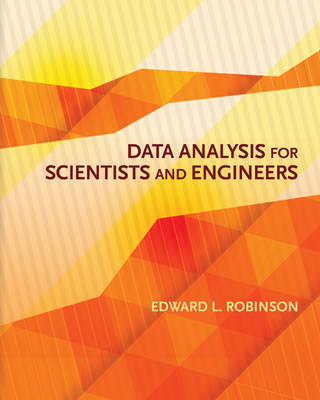
Stock image for illustration purposes only - book cover, edition or condition may vary.
Data Analysis for Scientists and Engineers
Edward L. Robinson
€ 116.43
FREE Delivery in Ireland
Description for Data Analysis for Scientists and Engineers
hardcover. Num Pages: 408 pages, 96 line illus. 7 tables. BIC Classification: GPH; PD; TBC. Category: (P) Professional & Vocational; (U) Tertiary Education (US: College). Dimension: 212 x 262 x 30. Weight in Grams: 1186.
Data Analysis for Scientists and Engineers is a modern, graduate-level text on data analysis techniques for physical science and engineering students as well as working scientists and engineers. Edward Robinson emphasizes the principles behind various techniques so that practitioners can adapt them to their own problems, or develop new techniques when necessary. Robinson divides the book into three sections. The first section covers basic concepts in probability and includes a chapter on Monte Carlo methods with an extended discussion of Markov chain Monte Carlo sampling. The second section introduces statistics and then develops tools for fitting models to data, comparing and contrasting techniques from both frequentist and Bayesian perspectives. The final section is devoted to methods for analyzing sequences of data, such as correlation functions, periodograms, and image reconstruction. While it goes beyond elementary statistics, the text is self-contained and accessible to readers from a wide variety of backgrounds. Specialized mathematical topics are included in an appendix. Based on a graduate course on data analysis that the author has taught for many years, and couched in the looser, workaday language of scientists and engineers who wrestle directly with data, this book is ideal for courses on data analysis and a valuable resource for students, instructors, and practitioners in the physical sciences and engineering. * In-depth discussion of data analysis for scientists and engineers * Coverage of both frequentist and Bayesian approaches to data analysis * Extensive look at analysis techniques for time-series data and images * Detailed exploration of linear and nonlinear modeling of data * Emphasis on error analysis * Instructor's manual (available only to professors)
Product Details
Publisher
Princeton University Press
Format
Hardback
Publication date
2016
Condition
New
Weight
1185g
Number of Pages
408
Place of Publication
New Jersey, United States
ISBN
9780691169927
SKU
V9780691169927
Shipping Time
Usually ships in 15 to 20 working days
Ref
99-15
About Edward L. Robinson
Edward L. Robinson is the William B. Blakemore II Regents Professor of Astronomy at the University of Texas, Austin.
Reviews for Data Analysis for Scientists and Engineers
With an accessible and consistent style, Data Analysis for Scientists and Engineers stands out for its depth of materials and pedagogical presentation. Building from simple concepts, the book's mathematical rigor and accuracy are solid and logical. This book is appropriate for senior undergraduates, graduate students at all levels, and practicing scientists.
Wade Fisher, Michigan State University Robinson's text is an excellent overview of modern statistical techniques and is sure to become a definitive reference. He ably and concisely presents all of the necessary foundational mathematics while also providing a thorough description of sophisticated methods used by practicing engineers and scientists. I particularly enjoyed the division of the book into frequentist and Bayesian approaches and Robinson's clear discussion of the relative merits of each method.
Jeremy Kasdin, Princeton University
Wade Fisher, Michigan State University Robinson's text is an excellent overview of modern statistical techniques and is sure to become a definitive reference. He ably and concisely presents all of the necessary foundational mathematics while also providing a thorough description of sophisticated methods used by practicing engineers and scientists. I particularly enjoyed the division of the book into frequentist and Bayesian approaches and Robinson's clear discussion of the relative merits of each method.
Jeremy Kasdin, Princeton University
